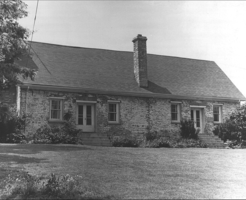 | Back to e-WV
| Back to e-WV
 The West Virginia Encyclopedia
The West Virginia Encyclopedia
 | Back to e-WV
| Back to e-WV
 The West Virginia Encyclopedia
The West Virginia Encyclopedia

Thanks to its most famous owner, the irascible Gen. Charles Lee, Prato Rio is one of West Virginia’s most eccentric houses. Lee bought the original log house, now a portion of the rear wing of Prato Rio, in 1775 from pioneer settler Jacob Hite, and gave it a Spanish name that translates ‘‘stream through the meadow.’’ Lee built a limestone addition, and gave it a unique arrangement. Instead of constructing partitions, he drew chalk lines on the floor to indicate various rooms. According to a visitor, the chimney ‘‘served in some degree to separate the cooking department from . . . bedroom, parlor, library, dog-kennel and all.’’
Lee, who was inordinately fond of his three hounds, named them Father, Son, and Holy Ghost, and avowed that ‘‘their breath was as sweet as man’s.’’ After his dismissal from the army during the Revolutionary War, Lee lived the life of a hermit at Prato Rio. Upon learning that George Washington, hoping for a reconciliation, intended a visit, he pinned a note to the door: ‘‘No dinner cooked here to-day.’’
Later owners have made additions and alterations (including partitions), but the house and its setting remain much as they were in Lee’s time. Prato Rio, on the western side of Jefferson County Route 1 in Leetown, is privately owned. The house was added to the National Register of Historic Places in 1973.
Read the National Register nomination.
Written by S. Allen Chambers Jr.